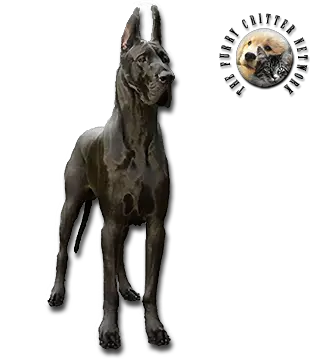Breed Standard
Head: Finely chiseled. Elongated, narrow. Very expressive. Always carried high. Strongly pronounced stop. Well developed superciliary arches. Broad nose bridge. Deep, rectangular muzzle. Black nose (lighter in the harlequin).
Ears: Set on high, naturally drop. Cropped to a point, carried rigid and erect.
Eyes: Medium size. Round. As dark as possible. Lighter eyes permissible in blue Danes. Lighter eyes or eyes of different color permissible in harlequin Danes.
Body: Square outline. Long, dry, muscular, well arched neck. Prominent forechest. Ribs well sprung. Wide croup sloping slightly. Belly well tucked up.
Tail: Medium length reaching the hocks. Set high, broad at the root tapering to a narrow tip. Curved slightly in the form of a saber when in action.
Hair: Very short, thick, smooth, shiny, lying close to the skin.
History
This large mastiff is thought to be descended from the Tibetan Mastiff introduced in Europe by the Phoenicians, then by the nomadic Persian Alans. In the Middle Ages, there were two varieties of this mastiff: A smaller Alaunt, powerful, agile, streamlined dog that hunted in packs for boar, wolf, and bear, and a heavier, more compact Alaunt used for guard duties. The immediate ancestors are the Bullenbeisser (now extinct) crossed with large hunting dogs descended from the more streamlined Alaunt. Later, names such as Ulm Dog, Great Dane, and Siberian Dog were used to indicate the different types of this breed. In 1878, all varieties were placed under the one name, Great Dane. The standard was written around 1890 in Germany. The French Doggen Club was founded in 1923.
Behavior
The Great Dane may be the most peace-loving of all the mastiffs. He is a gentle, tender, kind, sensitive, and affectionate dog, particularly with children. This stable, calm dog rarely barks and is never aggressive unless the situation warrants. He is alert, protective of his territory and his owners property, wary around strangers, and not easily swayed. His formidable size is enough to dissuade almost anyone. Training must start early. It should be firm, but undertaken with patience.
The Great Dane can be content living in an apartment, but he must get out daily to stretch his long legs. This athletic dog needs space and exercise. However, he should not exercise too vigorously until he has stopped growing, or he may damage his joints and ligaments.
Function
Guard Dog, Pet.
Health
Great Danes, like most giant dogs, have a fairly slow metabolism. This results in less energy and less food consumption per pound of dog than in small breeds.
Great Danes have some health problems that are common to large breeds. Bloat (a painful distending and twisting of the stomach (Gastric volvulus)) is a critical condition that can affect Great Danes and results rapidly in death if not quickly addressed. It is a commonly recommended practice for Great Danes to have their stomachs tacked (Gastropexy) to the interior rib lining during routine surgery such as spaying and neutering if the dog or its relatives have a history of bloat, though some veterinary surgeons will not do the operation if the actual sickness has not occurred. Elevated food dishes are often believed to help prevent bloat by regulating the amount of air that is inhaled while eating, although one study suggests that they may increase the risk. Refraining from exercise or activity immediately before and after meals may also reduce risk. They can live between 8-12 years.
Another problem common to the breed is in the hips (hip dysplasia). Typically an x-ray of the parents can certify whether their hips are healthy and can serve as a guideline for whether the animals should be bred and are likely to have healthy pups.
Dilated cardiomyopathy (DCM) and many congenital heart diseases are also commonly found in the Great Dane. Also, some Danes may develop yeast infections, when not fed all needed nutritional requirements. The yeast infection may also lead to minor recurring staph infection(s).
Great Danes also suffer from several genetic disorders that are specific to the breed. For example, if a Great Dane lacks color (is white) near its eyes or ears then that organ does not develop and usually the dog will be either blind or deaf. Many pure white Danes are deaf.






